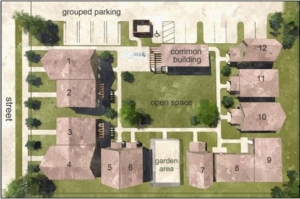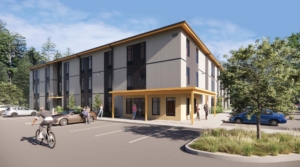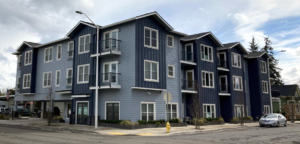
Housing Solutions Will Require Consensus, Collaboration, Cash and Time
A chronic shortage of housing has put upward pressure on housing prices, forced lower-income workers to drive long distances to their jobs and contributed to the homelessness crisis. Almost everyone agrees on the problem but the solutions will require consensus, collaboration, cash and time.
Nigel Jaquiss of Willamette Week reported on a new study by Up for Growth that says the United States suffers from a 4 million unit housing shortage. The Washington, DC think tank said Oregon is doing one of the poorest jobs of reducing its housing shortage, now estimated at more than 100,000 units.
There is a long list of reasons for the shortage of affordable and low-income housing – urban renewal, zoning requirements, construction costs, land availability and financial support.
Governor Kotek made housing a top priority and signed two bills approved by the 2023 Oregon legislature that provide $200 million, most of which goes to combat homelessness. It also implements the Oregon Housing Needs Analysis (OHNA) system, requiring cities with at least 10,000 residents to study their housing production needs for different affordability levels and housing types and take action to increase housing production through their zoning codes, permitting processes and other levers controlled by local jurisdictions.
“Policymakers and advocates must work together to ensure that all Americans have access to safe, affordable housing.”
 Ashland Housing Plan
Ashland Housing Plan
Ashland is one of the first Oregon cities to comply with the new state law. Ashland’s plan identifies 15 strategies that include a land bank, zoning changes, preservation of manufactured housing parks, a tax exemption for multi-family housing units, the addition of supportive housing and a construction excise tax.
The challenge for larger cities will be even more complex and expensive.
The Up for Growth report, citing U.S. Census Bureau data, says the nation’s housing shortage has continued to worsen. In addition to under-production of new housing units, the report says, “Chronic disinvestment, structural changes in industry and bankruptcy have resulted in more than 60,000 uninhabitable units.”
Mike Kingsella, who heads Up for Growth, claims, “Not a single state is providing enough housing for its citizens. Policymakers must make the straightforward but difficult choices to prioritize new funding sources that allow for diverse housing types, invest in construction innovations and bolster infrastructure funding despite the risks posed by NIMBY opposition.”
A key objective, Kingsella says, is to build more middle- and moderate-density housing units, which cost less to build than traditional single-detached homes, as well as more homes with better access to jobs, transit and community assets.
Complexity of Housing Shortage
 Marco Santarelli, a real estate investor, sums up the problem this way: “The housing shortage is a complex issue that affects different groups of people in different ways. Renters, homebuyers and low-income families are among the most affected by the shortage. For renters, the shortage has led to rising rents and increased competition for affordable housing. For homebuyers, the shortage has made it harder to find a home and driven up home prices. Low-income families are especially vulnerable to the housing shortage, as they are often unable to afford rising rents or the high cost of homeownership.”
Marco Santarelli, a real estate investor, sums up the problem this way: “The housing shortage is a complex issue that affects different groups of people in different ways. Renters, homebuyers and low-income families are among the most affected by the shortage. For renters, the shortage has led to rising rents and increased competition for affordable housing. For homebuyers, the shortage has made it harder to find a home and driven up home prices. Low-income families are especially vulnerable to the housing shortage, as they are often unable to afford rising rents or the high cost of homeownership.”
The housing shortage “has made it difficult for many Americans to find affordable homes,” Santarelli says. “According to the National Low Income Housing Coalition, there is a shortage of 7.2 million affordable and available rental homes for extremely low-income renters, defined as households earning less than 30 percent of the area median income. This shortage has contributed to a rise in homelessness, particularly in urban areas.”
Santarelli says the undersupply of housing has contributed to chronic worker shortages, suppressed economic growth and led to increased rates of mental health issues and chronic illnesses, especially among Black and Latino households. “From increasing new construction to reforming regulatory barriers, “ he urges, “policymakers and advocates must work together to ensure that all Americans have access to safe, affordable housing.”
The Bipartisan Policy Center has identified 10 actions governments can undertake to improve overall housing affordability. They include building more apartments, legalizing accessory dwelling units, eliminating or reducing parking requirements, speeding up permit processes, locating more affordable housing near transit, establishing affordable housing trusts, improving housing voucher programs and supporting community land trusts. The Ashland housing production plan includes several of those ideas.
 Newport Housing Plan
Newport Housing Plan
Urban renewal is the first strategy listed in Newport’s housing production plan. Earlier urban renewal projects have been blamed for destroying neighborhoods and tearing down old hotels that provided cheap housing and single-room occupancy rooms.
“The City would use urban renewal funds for infrastructure development or for programs that lower the costs of housing development,” the Newport housing plan explains. “It provides a flexible funding tool to support many of the actions in the House Production Strategy.”
Other Newport strategies include a homebuyer tax exemption. “The City would provide low- and moderate-income homebuyers a 10-year property tax exemption for homes valued at or below 120 percent of the city’s median sales price.”
Expanding urban growth boundaries (UGB) has been touted as important for increasing housing production. The Newport housing plan calls an agreement between the city and Lincoln County that “provides a common understanding on how land that may eventually be in the city limits will be managed and made easier to annex.”
 Ghost Homes Bill
Ghost Homes Bill
The Sightline Institute, a Pacific Northwest nonprofit dedicated to sustainability, says the current shortage is partially the result of housing that could have been built but wasn’t. The “ghost homes” included affordable apartment buildings, accessory dwelling units and multi-family housing in residential neighborhoods.
In a story posted in June, the organization touted a revolving housing loan fund that offers interest-free financing to cover the marginal cost of building low- or moderate-income housing. The scheme “would allow the State of Oregon to send money to people building relatively lower-priced homes around the state that can’t quite make their numbers work. Then, over the next 10 years, the state would recoup its interest-free loan out of a payment in lieu of taxes.”
The concept, co-authored By Rep. Pam Marsh, D-Ashland, and Senator Dick Anderson, R-Lincoln City, was embodied in House Bill 2980 in the 2023 legislative session. The House Housing Committee voted it out 8-2 after co-chair Rep. Mark Gamba, D-Milwaukie, called it a “brilliant, audacious idea”. However, th e bill didn’t survive the rushed late-session action following a six-week Senate Republican walkout.




